The modern era of mobile devices is pushing web apps to be more responsive and offer real-time interactions. For this, you need a reliable backend framework to create a robust database connection with the UI and synchronize data in real time.
Take an example of a live football game score on your smartphone that offers instant access to all the player stats. To build a such application, you must choose a backend framework with reliable architecture and tools.
Laravel and Symfony are frameworks with similar characteristics to develop multi-language, multi-user content with cross-platform capabilities.
Phew! That’s tough competition, but fret not! We have laid out a thorough side-by-side comparison of factors like features, pros and cons, performance, architecture, database support, and convenience of hiring resources. So without further ado, let’s get started
Overview of Frameworks – Laravel vs Symfony
| Differentiator | Laravel | Symfony |
| Performance comparison | Optimized apps perform well even at a latency of < 20 ms. | Consumes more memory and time |
| Application Architecture | Follows Model-View-Controller (MVC) architectural pattern |
It also follows MVC architecture |
| Scalability | Applications can be scaled using MySQL, AWS, and others |
It can be scaled conveniently using Kubernetes |
| Ease of testing | Comprehensive testing documentation for all the tests. |
Ease of running unit tests, functional tests, and integration tests |
| Microservices compatibility | offers microservice compatibility with a leaner version called Lumen |
Supports microservices through the Microkernel attribute |
| Database Support | Supports Postgres, MySQL, SQLite, and SQL | Supports Drizzle, MySQL, Oracle, PostgreSQL, SAP Sybase, and SQLite |
| Community | More than 635 contributors | More than 2746 contributors |
What is Laravel? – An Overview
Laravel is an open-sourced web framework known for its server-side handling of routing, HTML authentication, templating, and more. Created by Taylor Otwell, Laravel is written in PHP and is based on Symfony, which provides reusable PHP components/libraries.
Since it is a server-side-based framework, with Laravel, you can build applications with pre-defined architectures, customized backend logic, web portal, templates, and full-stack apps and manage SaaS products.
Market usage stats of Laravel
- Laravel holds 0.14% of the market share among all the web frameworks that exist today.
- The number of live websites using Laravel has risen above 658,421 with over 246,513 websites based in the US region.
- Laravel has 75.9k Github stars with 24.3k forks and 608 dedicated contributors who improve the real-time framework.
Use cases of Laravel
- SaaS-based web applications
- On-demand streaming web apps
- e-Learning web apps
- Stock trading based web management systems
- Web apps with rewards and recognition features
- Multilingual CMS systems
- Self-hosted website-performance monitoring apps
Popular apps using Laravel as the backend technology
- Laracasts, an e-learning website, offers various courses and serves as a platform where technical queries are answered and resolved by experts.
- Barchart, a financial portal, gained an advantage of the latest global market data in stock, currency exchange, trade offers, gold price, and more.
- Asgard CMS, a modular multilingual CMS, provides futuristic ready-to-use modules such as dashboard, media management, and flexible back-end support.
- World Walking, a charity-led healthcare platform, focuses on provoking people to do more walking by offering rewards and recognition programs.
- Neighborhood Lender uses Laravel as the backend support to serve as a mortgage calculator with a wide range of financial functionalities, making complex mortgage processes more comfortable and straightforward.
What is Symfony?- An Overview
Symfony is an open-source framework based on PHP that uses the MVC project design pattern. It enables developers to create scalable applications and experiment with the RAD (Rapid Application Development) environment. The framework allows for easy testing, debugging, and documenting of robust enterprise-grade applications.
Furthermore, the MVC architecture comes in handy as it lets you separate business logic from the presentation layer. This way, you can keep the app’s performance constant even while you make business logic changes. What’s more, Simfony can be used in conjunction with frontend technologies like AngularJs or React.
Here are the market usage statistics for Symfony,
- More than 48,518 companies use Symfony for their business solutions worldwide.
- It attracts 22,622,957 downloads per day from the official portal.
- There are 55,358 live websites based on Symfony, out of which 18,998 are in the US.
- Symfony has seen a surge in its usage, with 112,420 sites on the internet.
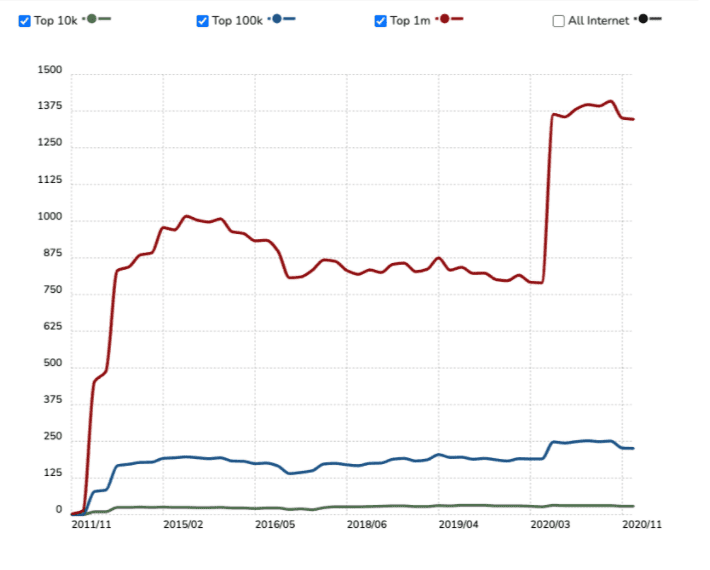
Use Cases of Symfony
- Single Page Applications
- Bulletin Board Software
- Content Management System(CMS)
- Social Networking Sites
- Intranet software and tools
- Enterprise Grade Applications
What are popular apps made with Symfony?
- Spotify– Created a highly customizable platform with Symfony that was flexible for adjustments and suitable to their target audience.
- BlaBlaCar- Leveraged Symfony as a backend to help users access data quickly for booking and tracking their rides.
- Course Hero- Used it to optimize timetable, task management tools, emails, and the database of courses to enhance users’ performance.
- Trivago- Used it to create an advanced search and comparison tool for hotels on its platform across devices.
- Vogue- Used it to create database “shelves” of their content in French and Dutch for readers to access through websites.
Laravel vs Symfony— Pros and Cons
Pros of Laravel
Pre-packaged tools: Facilitates common tasks required for building web applications by offering ready-to-use packages for user authentication, testing APIs.
Templating system: Uses a templating engine known as Blade, which offers enormous power to format data and create complex web-app layouts with easy navigation. It allows the addition of new modules and features without making any change in the core.
Automation with Artisan CLI: Offers the ability to automate any kind of recurring task which is application-specific. It generates modern boilerplate codes to manage databases, migrations, and implement custom commands conveniently.
Routing: Reverse routing is a unique feature that supports the automatic propagation of changes in routes into relevant links. In other words, it automatically creates Uniform Resource Identifiers (URIs).
Automated testing: Offers expressive testing methods with PHPUnit that simulates user behavior by making requests to the application’s functions. This way, testing is less time-consuming and automated.
Cons of Laravel
Lightweight: Typically, the lightweight feature of this framework is considered an advantage, but in this framework, the lightweight nature leads to excessive backend congestion of database queries, ultimately leading to lower performance with an increase in data congestion.
Library quality: While Laravel might be open-sourced and backed by a vast community, it also leads to an increase in less reliable third-party libraries.
Community: Since the Laravel community is considerably large, the number of third-party libraries built and published is significant. It becomes difficult to evaluate which library is reliable and quality certified.
Pros of Symfony
- Saves Time- With this framework, developers can write code within a day due to reusable components, which otherwise takes up to three days.
- Flexibility- Offers to change code right from the beginning to customize the apps and web solutions.
- Twig Engine- Uses the most popular stand-alone PHP template engine among other frameworks.
- Expandability- This allows you to leverage preloaded bundles to expand functionalities.
- Stability- Offers stability across all the versions with lifetime support for security issues.
Cons of Symfony
- Parsing Issues- Parser and lever codes are hard to access in the framework, making it difficult to test these codes in time.
- Performance- Lower performance in real-time loading of applications when many users are using the app at the same time.
- Hard to Master- Needs more time and dedication to master the framework due to complex concepts behind the framework.
- Slower to build apps- The design pattern in the framework needs more technical know-how, which consumes more time to build and launch the application.
Laravel vs Symfony— Performance Comparison
How does Laravel stand out in terms of performance?
The performance of Laravel-based applications can have implications on the success of a project, and it is said to be slow. But, its community suggests that it can be improved for better performance if optimized appropriately, which may allow applications to perform efficiently even under 20ms.
Usage of Cache tags allows applications to quickly load the pre-stored information that allows a faster response time, leading to improved performance.
How does Symfony stand out in terms of performance?
Symfony performs better than many other frameworks in terms of large-scale development and ease of use. There was a comparison conducted on different PHP frameworks, including Symfony.
In this study, an empty project was generated with the installer tool in Symfony, which offers a bundle inside the newly created project. The next step is to configure files and add database connectivity.
A couple of code lines are added to handle input validations and sanitization. Here, an in-built tool in Symfony is used to create a blog entry implementation project by scaffolding. The results are as follows:
Execution Time Experiment- Symfony has the highest execution time among other frameworks for the CRUD (Create, Read, Update, and Delete) action.
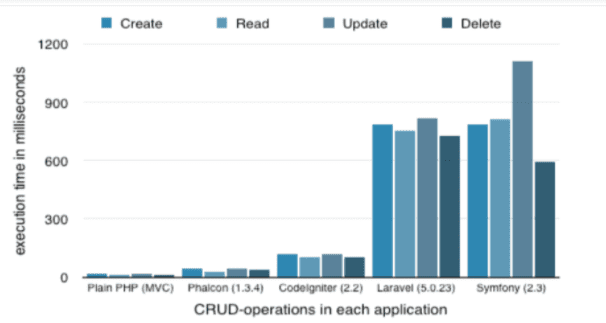
Memory Consumption: Here, also the framework consumes the highest memory in comparison with others.
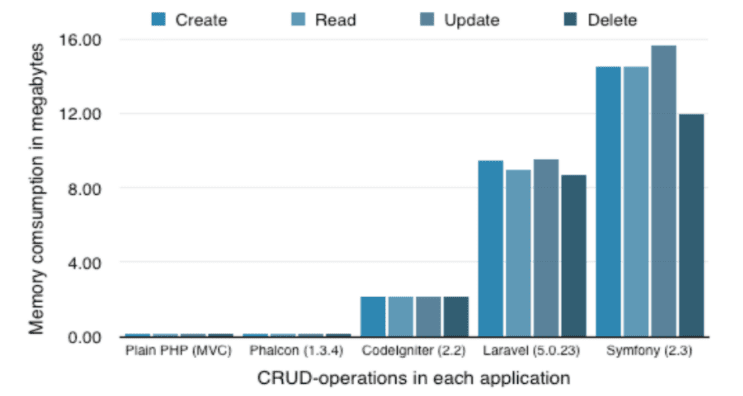
Stack Trace Experiment- It has the deepest stack trace with 1,504 call functions on creating CRUD action.
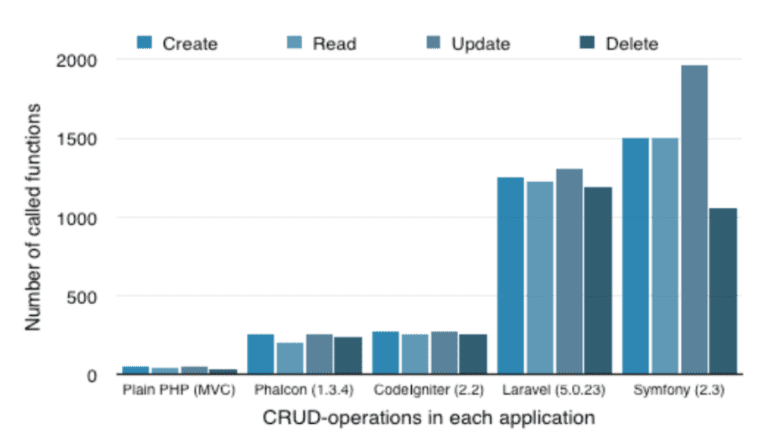
Symphony may seem to consume more memory and time, but you might want to consider that it supports large-scale projects.
Laravel vs Symfony— Application Architecture
What kind of architecture does Laravel support?
Laravel follows the Model-View-Controller (MVC) architectural pattern that provides the ability to split developer roles for a more comfortable development process. In other words, while a frontend developer is working on the views, a backend developer can be working on the controller logic simultaneously.
The MVC patterns also offer full control over the application, which might come in handy to choose application-specific routes and customize how your application appears on a global scale. This improves the SEO of the application in return as well. Implementing external APIs and reusing application logic is effortless with Laravel’s MVC architecture. Thus, the creation of immutable backend support for any web application is always possible.
What kind of architecture does Symfony support?
Symfony follows the MVC architecture with three distinctive components- Model, View, and Controller. MVC architecture keeps the business logic separate from the presentation layer. So, all you need to do is change the View part when users switch from standard web browsers to handheld devices.
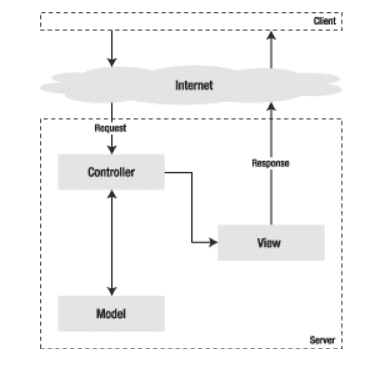
The Controller manages to keep the request protocol (HTTP, mail, or others) hidden from the Model and View parts. Additionally, an abstraction of data by the Model makes it independent of the View part to offer flexibility.
Laravel vs. Symfony— Scalability
Is Laravel scalable?
Popular apps using Laravel for years are scaling up their applications without any limitation. Laravel inherits scalability from PHP as it proffers support to rapidly growing businesses. By choosing a good database and load balancer, Laravel can achieve massive horizontal scaling.
Laravel applications can be scaled as per requirement by using MySQL, AWS and some advanced caching methods.
How Scalable is Symfony?
Symfony-based applications can be scaled conveniently according to requirements using Kubernetes. The framework is a cluster of different reusable components used with external containers for better scaling. Scaling your application means increasing the number of production instances to handle more user requests. There are two things to keep in mind while you scale your Symfony application,
- Use Redis to store the cache and sessions.
- Leverage FlySystem as an option to managed filestores.
Love Laravel? Here is a detailed comparison between Django and Laravel for you
Laravel vs. Symfony— Ease of Testing
How easier is it to test a Laravel app?
Given the fact that Laravel functions with PHP, there are many testing tools available to ensure the creation of a bug-free application. However, it is understandable to feel overwhelmed by the number of tools and resources available for testing. To make the testing process more comfortable, Laravel tests code in two distinct levels known as Unit tests and Feature tests.
Laravel, by default, has robust testing documentation and provides all the tools you need to test the application environment at several levels, including the ability to conduct mock tests by mocking application codes and events.
How easier is it to test Symfony applications?
Symfony supports profiler tools like PHPUnit Pretty Printer and Blackfire that make testing effortless. Apart from these capabilities, it offers doctrine bundles that can be used to create reliable and rapid testing suites.
Moreover, to create and reset fake information in your app’s database through a single command, you can use pre-defined functions or classes like DoctrineFixturesBundle. All in all, with Symfony, you can run unit tests, functional tests, and integration tests with ease and flexibility of preconfigured testing.
Laravel vs. Symfony— Microservices compatibility
Is Laravel compatible with microservices architecture?
PHP supports microservices architecture, and it is evident that Laravel supports microservices architecture as well. How does Laravel do it? The app is broken down modularly into small building blocks, each with its function and responsibility. These functions communicate with each other using language-agnostic APIs, and as a result, the app becomes compatible with the microservices architecture.
For the past few months, the need to use Laravel with microservices architecture was so intense that a developer came up with a framework – Lumen. It serves a similar purpose and is a leaner, smaller, and lighter version of Laravel.
Is Symfony compatible with microservices architecture?
Symfony supports microservices through the Microkernel attribute. It helps the framework load the application with fewer lines of code, making the deployment faster. The kernel helps to create service containers that have individual functions. So, each time a user interacts with the app, these services execute functions according to the application logic.
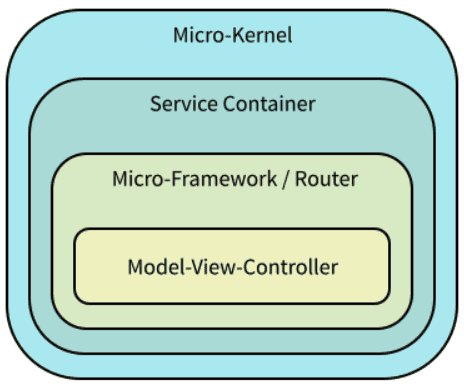
Laravel vs. Symfony— Database support
How good is the database support for Laravel?
Laravel currently supports four database system types: Postgres, MySQL, SQLite, and SQL. The fluent query builder, raw SQL, and Eloquent ORM make the process of interacting with these databases simple. Even establishing multiple database connections is more comfortable to configure with Laravel.
Whether other databases will support Laravel, only the future can tell. But say, you are comfortable with the databases that Laravel supports, you will face no limitations in creating a wholly controlled relationship between the database and the web app.
How good is the database-support for Symfony?
Symfony supports databases like,
- Drizzle
- MySQL
- Oracle
- PostgreSQL
- SAP Sybase SQL Anywhere
- SQLite
- SQLServer
It enables database connection for your application through Doctrine ORM. The framework uses data mappers for mapping objects to the database. It separates the object model and database schema, allowing the freedom to change the database columns without tweaking the codebase.
Laravel vs. Symfony— Community
How big is the community around Laravel?
PHP holds 79% of the market when it comes to server-side programming of web applications. Laravel has a vast community with more than 46,231 active users, 18,105 threads, 63.5k Github stars, and 4.7k real-time watchers.
The maximum time taken to resolve a Laravel query by the community is not more than three days. PHP and Laravel combined have a powerful community, where developers share Laravel podcasts, news, documents, repositories, etc. Following are some of the places where you can meet the Laravel community:
How big is the community around Symfony?
Symfony is famous for its permanence. It has more than 600,000 developers across 120 countries contributing to the community. The parent entity responsible for Symfony and Blackfire – Sensio Labs – has investors like Slack and Stackoverflow.
Apart from the dev community, the framework has a social community called SymfonyConnect, where official community members interact and share their experiences. In addition to this, you could also connect with Symphony developers through Slack, Stackoverflow, and Reddit.
Laravel vs. Symfony— Hiring developers
How convenient is it to hire Laravel developers?
With the vast community of PHP and Laravel worldwide, it is no rocket-science to hire a Laravel developer. You can almost find a Laravel developer in every corner. But it is essential to keep in mind that rookies might find it challenging to handle its advanced features. Hence, the ones you hire must have the know-how of handling Artisan, Eloquent ORM, and caching. The average charge for employing a Laravel developer is around $15 to $30 per hour. Laravel also offers an official platform to find Laravel developers.
How convenient is it to hire Symfony developers?
Symfony developers are convenient to hire depending on the skill base you are looking for and the location. For example, a highly experienced developer may cost you higher than a beginner. You can also look to hire a PHP developer with knowledge of the Symfony framework. Similarly, a Symfony developer from Eastern Europe is cheaper than the one from Northern America. Here are the hourly rates for developers across some locations in the world.
- The average rate of Symfony developers in the United Kingdom is around £20/hour.
- In Switzerland, the average per hour rate developers charge is $41/hour.
- The average hourly rate in the US is between $3/hour to $21/hour.
- In Canada, a junior developer charges around $2/hour, and an experienced developer can charge up to $16/hour.
- The hourly rates that entry-level developers charge in Ukraine are $1.5/hour, and senior-level developers charge around $5/hour.
Laravel vs. Symfony: Server requirements
What are the server requirements for Laravel?
The Laravel framework has specific server requirements, which include a PHP version of 8.1 or higher with the following extensions,
- Ctype PHP Extension allows you to check and manipulate characters in a string
- cURL PHP Extension allows for making HTTP requests in Laravel
- DOM PHP Extension is used for parsing HTML and XML documents in a programmatic way
- Fileinfo PHP Extension identifies file types and provides file information
- Filter PHP Extension validates and filters data inputs
- Hash PHP Extensionprovides secure hashing algorithms used for password hashing in Laravel
- Mbstring PHP Extension provides multi-byte string functions used by Laravel
- OpenSSL PHP Extension allows for encrypted connections and secure data transfer
- PCRE PHP Extension provides regular expression support
- PDO PHP Extension enables access to various database management systems
- Session PHP Extension manages user sessions in PHP applications.
- Tokenizer PHP Extension provides support for parsing PHP code
- XML PHP Extension enables parsing, manipulating, and generating XML documents in PHP applications.
What are the server requirements for Symfony?
Symfony lets you use any web server like Apache, Nginx, the internal PHP web server, etc. However, it also provides an in-built server that you can use. Here are some prerequisites that you need before using Symfony,
- PHP version of 8.1 or higher
- Ctype provides functions for character type validation, needed by Symfony’s Validator component
- Iconv ensures proper text encoding/decoding between web apps and users’ browser
- JSON is typically included in modern PHP installations, and used for data interchange
- PCRE enables core features such as routing, validation, and security
- Session PHP Extensionmanages user sessions in Symfony apps, necessary for proper session management
- SimpleXML PHP Extension parses and manipulates XML data, essential for handling XML data in Symfony applications
- Tokenizer PHP Extension parses PHP code into individual tokens, useful for automated code analysis and required for some Symfony features, such as generating optimized autoloaders.
Laravel vs. Symfony: Installation process
How to install Laravel?
Installing Laravel is a multi-step process that begins by installing the PHP on your system. Here are further steps to install Laravel,
Laravel installation requires PHP version 8.1 or higher and Composer, a dependency manager. You can download and install PHP from the official website and Composer from getcomposer.org.
Further, Laravel provides a command-line tool called “Laravel Installer” that makes it easy to create new Laravel projects.
You can install it globally on your system using Composer. However, downloading and installing the Laravel composer can vary for different operating systems.
- MacOS-Install PHP and composers required using Homebrew.
- Linux-It will have Docker Compose pre-installed, which you can use to create a new Laravel project.
- Windows- Install Docker Desktop on your Windows machine before installing Laravel. Further, ensure you enable Windows Subsystem for Linux 2(WSL2). It allows you to run Linux binary executables natively.
Once you have installed PHP and composer, you can create a new Laravel project by using the following command line,
composer create-project laravel/laravel example-app
Or, you can use a global installing Laravel installer through Composer,
composer global requires laravel/installer
laravel new example-app
Once you create a Laravel project, use Artisan CLI to start local development on the server.
cd example-app
php artisan serve
How to install Symformy?
To start creating Symfony applications, ensure you have all the server requirements ready. You need to have PHP 8.1 or higher installed on your system and extensions like Ctype, iconv, PCRE, SimpleXML, etc.
You can download and install the composer used to install PHP packages. Alternatively, you can use Symfony CLI, which creates a binary called “symfony” that provides all the tools required to develop and run the Symfony app locally.
Further, you can use this binary to check whether your system meets all the requirements by running the following command:
symfony check: requirements
Next, open the console terminal and run the following commands to create a Symfony app:
symfony new my_project_directory --version="6.2.*" --webapp
symfony new my_project_directory --version="6.2.*"
If you are not using the binary, use the following commands:
composer create-project symfony/skeleton: "6.2.*" my_project_directory
cd my_project_directory
composer require webapp
composer create-project symfony/skeleton:"6.2.*" my_project_directory
Laravel vs. Symfony: Template engine
Laravel and Symfony provide template engines to separate presentations from business logic. The template engine provided in Laravel is called Blade and Twig in Symfony. The blade is simpler to use, but it may be slightly more difficult for beginners.
Laravel’s Blade also provides built-in caching support, which stores compiled templates for faster performance. Meanwhile, Twig also offers caching support but requires manual configuration.
Additionally, Blade provides basic functionality for creating custom directives, while Twig offers extensions that help extend functionality and create custom filters, functions, and tags.
Laravel vs. Symfony: Data modeling
Both Laravel and Symfony offer data modeling capabilities but differ in some aspects. For example, Laravel’s data modeling is done through an Object Relational Mapping (ORM) tool called Eloquent, which provides a simple interface for defining database tables and their relationships.
Eloquent supports various methods for querying and modifying data and relationships between models, such as one-to-one, one-to-many, and many-to-many relationships.
On the other hand, Symfony provides several data modeling options through Doctrine, an ORM tool. Doctrine provides a powerful and flexible way to map objects to database tables. It uses a combination of annotations and configuration files to define database tables and their relationships.
Conclusion
Laravel has the advantage of pre-defined architecture that makes customization of backend logic easier. At the same time, Symfony offers reusable components to create scalable applications. The choice between Laravel and Symfony depends on the kind of application you want to develop.
Choose Laravel, if:
- You want to build interactive website layouts with appealing content.
- You want to create an advanced application without adding any overhead of components or additional costs by leveraging the Blade Template Engine.
- You want to take advantage of various widgets with JS and CSS compatibility to create customized web apps.
- You require a scalable server-side framework with excellent documentation and constant support from a large community.
- Your project requirement is to build a web application quicker and faster with object-oriented libraries.
- Your goal is to create an SEO-friendly and reliable web application with high security.
Choose Symfony, if:
- You want to build large-scale enterprise-grade applications.
- You want to create web apps with real-time data synchronization.
- You want a search engine feature, which you can create through the Zend Lucene library.
- You want to create a customizable marketplace for buyers and sellers.
- You need a collaborative suite for enterprise applications through the intranet.
- You want to create a single-page application for your business.